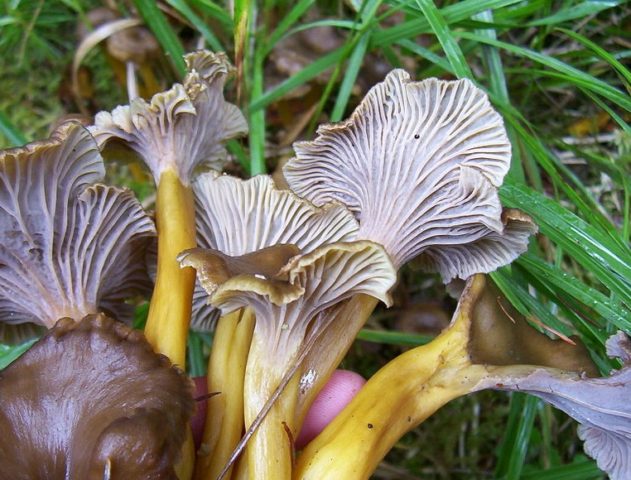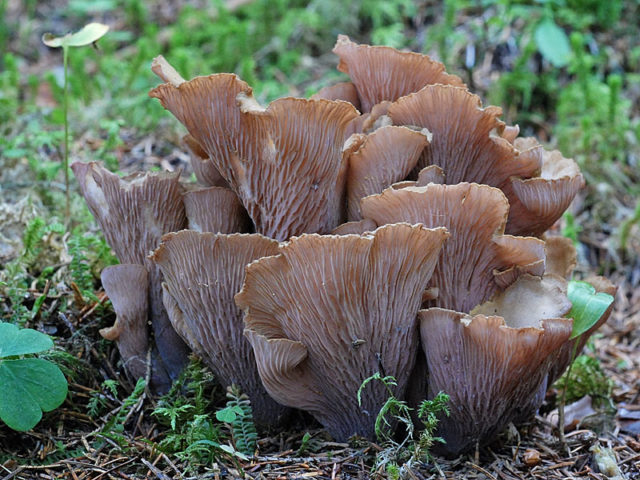Content
Chanterelle yellowing is not a very common mushroom, however, it has a lot of valuable properties and interesting features. In order not to confuse the fungus with others and properly process it, you need to learn more about it.
Where yellowing chanterelles grow
The yellowing chanterelle in Russia is found everywhere, but quite rarely. The mushroom settles mainly in coniferous forests, it can often be seen under spruce trees, in an accumulation of moss or fallen pine needles, on calcareous moist soils.
You can find a fungus from the beginning of August to September, it is during this period that fruiting reaches its peak. The fungus grows both singly and in rather large groups.
What yellow chanterelles look like
The fungus has a small yellow-brown cap in the form of a deep funnel. The edges of the cap are curled up, the lower surface in young fungi is almost smooth, and in adults it is wrinkled, with well-defined folds. The cap of the fungus smoothly turns into a curved leg, tapering closer to the base.
The length of the chanterelle's leg is small, about 7 cm on average and no more than 1.5 cm in girth. The shade at the leg is yellow, but from the inside it is hollow.
The pulp of the fungus on the cut is dense, yellowish, without a pronounced odor. The characteristic difference between the yellowing chanterelle is that the flesh of the fungus is slightly rubbery in structure, although this does not prevent it from being brittle.
Is it possible to eat yellowing chanterelles
The yellowing chanterelle is a completely edible mushroom. It can be eaten both after processing and in dried form - there will be no harm to the body from this.
Taste qualities of mushrooms
In terms of taste, the fungus belongs only to the 4th category, which means that it cannot please with a particularly rich and pleasant taste. Nevertheless, in cooking, the yellowing chanterelle is used very willingly.
The fact is that the dense pulp of the mushroom retains its structure even after heat treatment. The mushroom can be boiled, dried, fried and salted, it will remain as neat and attractive as fresh.
Benefit and harm
The yellowing chanterelle, when properly processed, has a very beneficial effect on the human body. It includes:
- potassium and fluorine;
- zinc and copper;
- cobalt and magnesium;
- sulfur and manganese;
- quinomannosis;
- vitamins;
- amino acids.
Due to this, the fungus has a lot of valuable properties:
- When consumed, the body's immune defenses are enhanced, the condition of the skin improves and the number of acne and boils decreases.
- Eating chanterelles is useful for angina and any colds, eye ailments and even tuberculosis.
- Also, the mushroom is able to have a beneficial effect in diseases of the stomach, pancreas, heart and blood vessels.
- Despite the rich chemical composition and high nutritional value, yellowing chanterelles are very low in calories. They can be safely eaten on a diet or with a tendency to obesity.
- With the frequent use of beneficial mushrooms, the body is cleansed of toxins, salts and radionuclides, the fungus has a positive effect on joint ailments, liver diseases, anemia and sleep problems.
Also, the fungus is used for cosmetic purposes. The extract from the yellowing chanterelle effectively helps to get rid of inflammation and irritation of the epidermis and softens the skin.
Of course, for all its useful properties, the yellowing chanterelle can be dangerous. It is not recommended to eat it when:
- pregnancy;
- under 3 years of age;
- individual intolerance;
- chronic and acute ailments of the kidneys and intestines.
The rest of the mushroom is quite safe for health, provided that the fungi are collected in an ecologically clean area.
Collection rules
The season for yellowing fungi begins in August and lasts until September, at which time you should go in search of them. It is necessary to collect fungi in places as far as possible from major roads, cities and industrial facilities. Any mushrooms have the ability to accumulate toxic substances in themselves, so the benefits of chanterelles collected in a polluted area will be very doubtful.
When collecting mushrooms, it is not recommended to remove them from the soil along with the stem - this destroys the mycelium. You need to cut off the yellowing chanterelles with a sharp knife, then the underground system of the fungus will remain intact, and next season it will be able to give a new fruiting body.
False doubles
The yellowing chanterelle cannot be confused with poisonous and hazardous mushrooms. However, she has twins, they are also suitable for eating, but they belong to other types of mushrooms.
Tubular chanterelle
This species is similar to a photo of a yellowing chanterelle in size and structure. It also has a funnel-shaped head with jagged, downward-curved edges and a tubular, dull yellow stem. The mushrooms are also similar in color, although the chanterelle has a tubular top of the cap that is gray-yellow, yellow-brown or slightly reddish.
Like the yellowing chanterelle, the tubular chanterelle grows mainly on acidic soils in coniferous forests, next to spruces and pines, in mosses and on rotten wood. But the peak fruiting of this mushroom falls on the period from September to December - this is somewhat later than that of the yellowing variety. Most often, the tubular mushroom does not grow alone, but in whole rows or ring groups.
Club chanterelle
Another edible mushroom with a funnel-shaped cap with wavy edges has a yellowish tinge in adulthood, but young club-shaped fungi are slightly purple. The mushroom legs are smooth and dense, light brown.
Unlike the yellowing chanterelle, the clavate chanterelle grows mainly in deciduous forests, although it can also be found on wet soils, in grass and mosses. The ripening peak of the fungus occurs at the end of summer and autumn.
Application
Yellowing chanterelles are suitable for any heat treatment, they are boiled, fried, pickled and salted. Since fresh mushrooms are never infested with parasites, they are often simply dried in the fresh air and then added to the first or second courses for an unusual flavor.
The fungus goes well with most spices and herbs, and is suitable for use with potatoes, meat and vegetables.
Boil the mushrooms for a very short time, only about 15 minutes.But when pickling fungi, it is recommended to keep them in a jar closed as long as possible - the mushrooms are quite tough and should be properly soaked in brine.
Conclusion
The yellowing chanterelle does not belong to the category of noble mushrooms, but it suits almost any dish and has a very pleasant taste and texture. The use of this mushroom brings health benefits, and it is almost impossible to get poisoned with a yellowing fungus.












